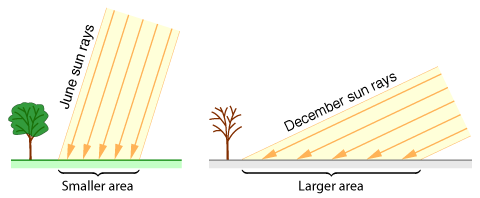Which planet has ALL of the following characteristics:
Its largest moon is named Titan.
It is made up mostly of gases.
It is surrounded by rings.
It is the sixth planet from the sun.
Saturn
Why the sun is not visible during the night?
The side of the Earth we are on is facing AWAY from the sun.
What is the name of the largest star that we know of?
VY Canis Major
The following table shows three characteristics of some planets in our solar system.
Which planet belongs on line Z in the table?
Jupiter
Mercury
Neptune
Venus
Venus
Remember V=Venus and V=Volcanoes!!! It's the hottest planet!!!
What are the 2 halves of the Earth called?
Northern Hemisphere
Southern Hemisphere
During which season does the angle result in the greatest area covered by the rays?

During which season does the angle result in the greatest area covered by the rays?
Winter
2 part Question: 1) Explain what kind of moon you would want to see if you wanted to study its features and surface. 2) How can we know what day and when will be the best to view it?
Full Moon
Look at a lunar (or moon) calendar and find the date that shows the FULL MOON.
Describe the difference between the inner and outer planets.
INNER: 1: Smaller in size 2: Made of rocky material 3: Not a lot of moons 4: Closest to the Sun
OUTER: 1: Known as Gas Giants 2: Made of Gas or Gas and Ice 3: Farthest from sun 4: Lot of Moons
Why does the Southern and Northern Hemisphere experience opposite seasons?
Because when one side of the Earth is pointing towards the Sun (summer) the other side of the planet is pointed away from the Sun (winter).
If VY Canis Major is the largest known star, why does it look so small when compared to the sun?
Because the Sun is closer to Earth than VY Canis Major is.
Compare and contrast Stars and Planets
(Give at least 4 answers for each column)
STARS BOTH PLANETS
STARS: In our galaxy/Too many to count/Cannot support life/Gives Off light/ Can burn Out/ Does not move/Balls of BURNING gas
PLANETS: Made of rocks, or gas and/or ice/8 major planets/1 can support life/Orbits the sun/Does not give off own light/Basically "forever"/ In our solar system
BOTH: In space/round/vary in sizes/vary in colors/vary in temperatures